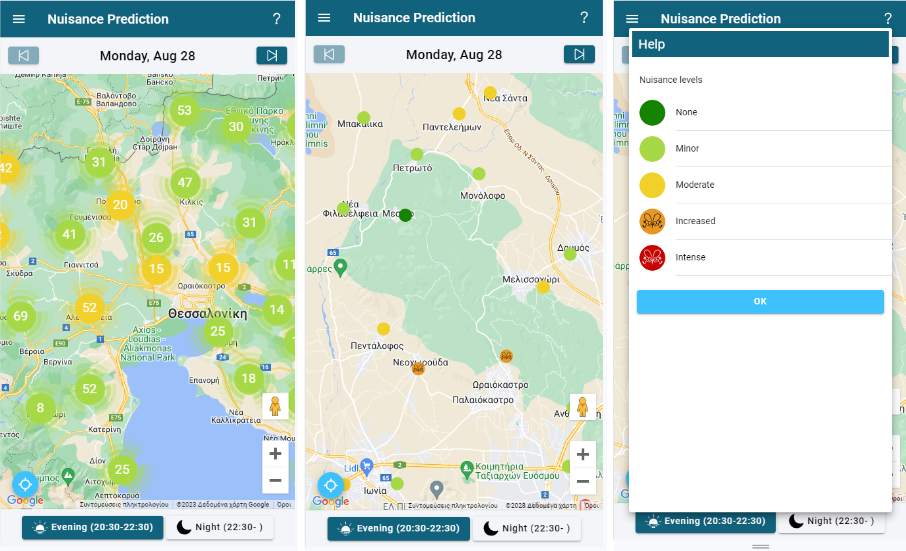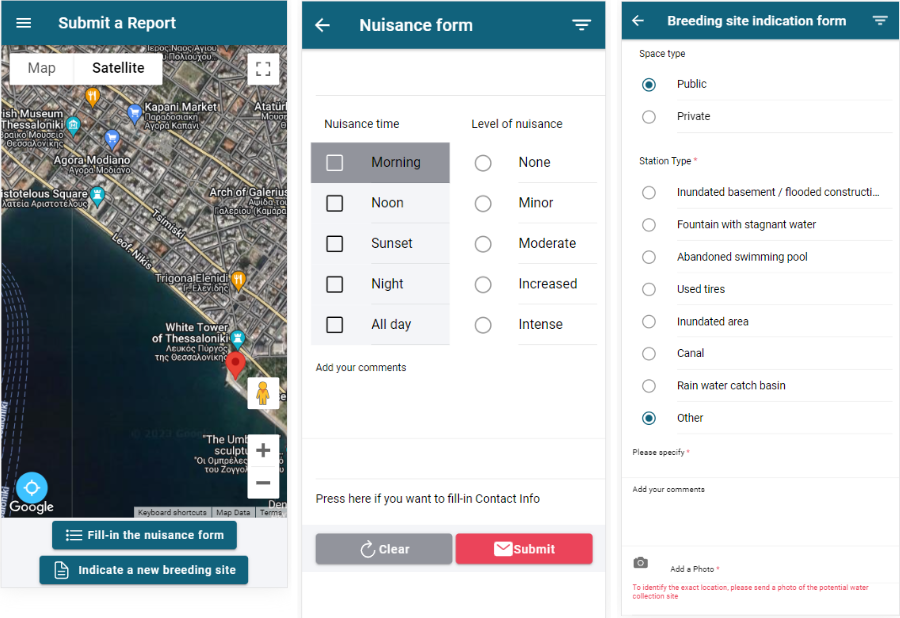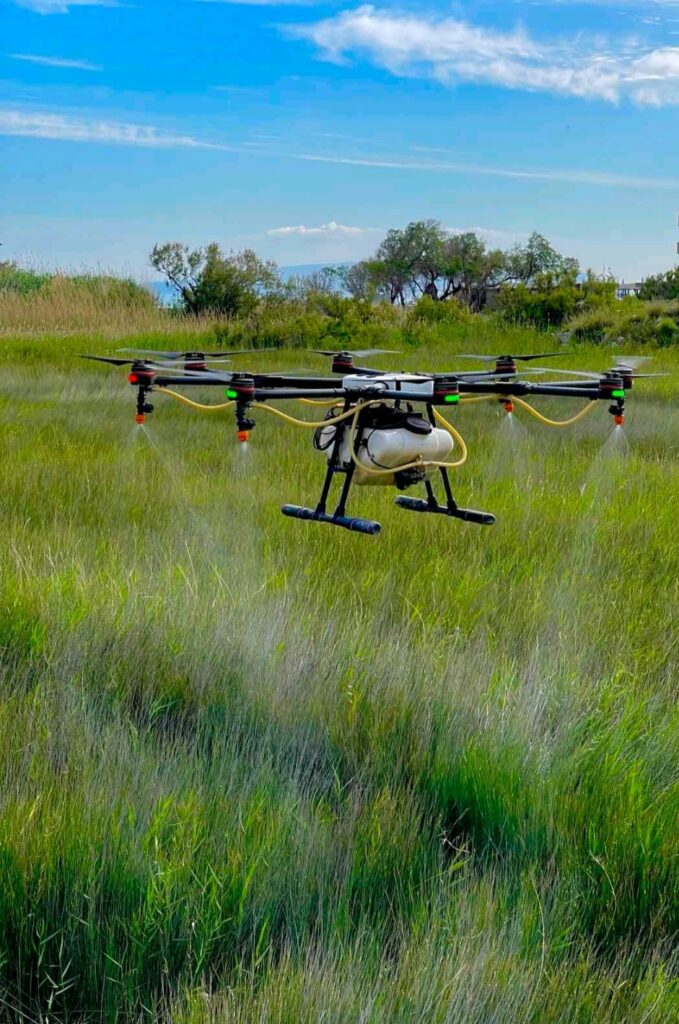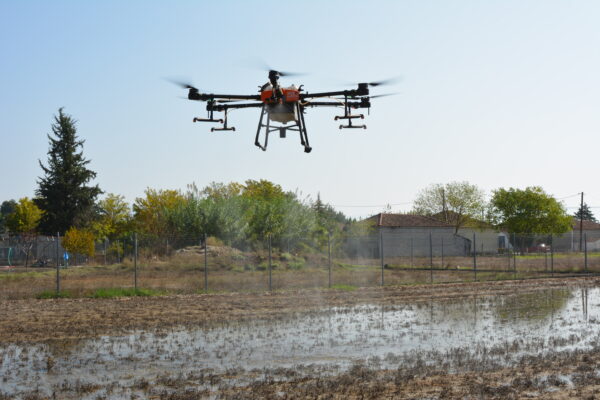Ecodevelopment- Mosquito Vision: A special innovation that predicts nuisance and danger from mosquitoes
A few years ago, it was impossible to talk about “predicting mosquito congestion and danger” the next day, as it is done with the weather.
However, a few years ago, a company from Thessaloniki, a leader in large-scale mosquito control projects in Greece and Europe, innovates with an application that relies on Artificial Intelligence tools, offering users the ability, in the first phase, to know the “mosquito weather” in the coming days.
The company “Oikoanaptixi,” an environmental applications corporation that has been implementing the majority of mosquito control programs throughout Greece since 1997, also serving as a significant partner for public health services in the control against diseases transmitted by mosquitoes, has introduced an innovative digital application called Mosquito Vision.

In simple terms, this application, compatible with Android and iOS systems of smartphones, shows in which areas there will be more mosquitoes in the next five days. This forecast allows residents and visitors of the area to prepare accordingly.
The application was initially developed to provide timely and accurate information regarding mosquito populations and better monitoring of the mitigation operations implemented every year in the Region of Central Macedonia. Actually, it was the result of a bilateral research project between Greece and Germany, funded by the General Secretariat for Research and Technology. Eventually it became the first application worldwide with these characteristics, offering the potential to predict at a settlement level. Initially, it covered 1040 settlements in the Central Macedonia Region, an area where in 2010 emerged the first endemic mosquito borne disease in Europe, after the end of the antimalaria campaign, namely West Nile virus.

The spread of WNV cases over the next decade (2010-2020), both in other regions of the country and the health policy of the European Commission concerning vectors that threaten the entire EU, triggered the development of the Mosquito Vision application. The expansion of the system to other regions of Greece (Western Greece, Crete, Thessaly) also sparked the interest of European organizations and health services active in prevention and control systems for vectors.
Mosquito Vision today in essence merges as a valuable tool for the built environment, especially for coastal tourist areas and regions adjacent to wetlands, rivers, rice fields, irrigation systems, etc.
To generate predictions, Mosquito Vision uses a plethora of hydro-meteorological, climatological, geographical, entomological, and other data from satellite indicators, land use, as well as field observations (sampling in mosquito breeding grounds, measurements in urban environments, etc.). It has become the most promising application that, in its final form, can lead to risk maps for potential disease vectors threatening public health for communication and operational purposes.


During the period when Ecodevelopment was developing this specific application, creating the technological and digital infrastructure for leveraging the multi-year data it had acquired from its experience both within and outside Greece, the EU – already before the emergence of the Sars Cov 2 virus—was urging European public health services to be vigilant. Hence, it was requesting measures and prevention plans for epidemics caused by viruses transmitted by mosquitoes, such as the West Nile virus, malaria, dengue fever, chikungunya, zika virus, and others.
There had been previous outbreaks of diseases transmitted by mosquitoes in European countries, and the assessments regarding new threats to public health due to climate change, with the notable feature being the movement and increase of mosquito species capable of causing epidemics in more northern regions of the EU.
The EU requested the development of national plans from its 28 member states regarding the control and management of disease vectors. “Given the alarming increase in diseases caused by vectors in the European Region,” the European Commission called for “strengthening the preparedness and cooperation of European Union member states, as significant variations are observed at the operational level in controlling vectors among different member states, while problems are identified both at the research and scientific level and in coordination and governance. A relevant directive concluded that the “swift adoption of new tools is necessary to emphasize the abatement of vectors in urban areas.”
The Thessaloniki-based company preceded the “adoption of new tools” chronologically with its Mosquito Vision application. Mosquito Vision constituted the main pillar of the original Early Warning System for Mosquito-borne Diseases (EYWA), one of the five pillars submitted within the framework of the Horizon Prize program of the European Innovation Council (EIC). It was awarded the first EIC prize for Early Warning in epidemics for its innovative functionality, which is now one of the most significant “weapon” for the EU to address critical public health needs in member states for the prevention and protection against vector-borne diseases.

The system combines interdisciplinary fields (entomology, epidemiology, ecology, Earth Observation, Big Data Analytics, Artificial Intelligence/Machine Learning, Data Fusion, and Citizen Science) to build new routes in applied research and innovative services for public health. These include epidemic prediction and decision support systems for vector control applications and other mitigation actions.
This specific award is one of the six major prizes awarded by the EIC, since its launching in 2015. The call was announced on April 26, 2018, and was conferred on January 17, 2022. The use of EYWA in the Central Macedonia Region during 2020-21, according to the Commissioner for Research of the European Union, “led to a 50% reduction in mosquito populations and prevented cases of West Nile Virus in 65 settlements.”
The main users of the pilot operation of the epidemiological risk prediction system for West Nile Virus, EYWA, are, from 2020 onwards, four regions in Greece: Central Macedonia Region, Western Greece, Thessaly, and Crete, as well as the Veneto region in Italy. Until 2025, the use of EYWA will be attempted in other regions of four European countries, following the application standards in the Central Macedonia Region.
EYWA is currently based on the following five pillars:
- Risk Knowledge: Focused on the Central Macedonia Region, it involves studying the risk in a pivotal area.
- Data Collection Networks: Utilizes networks for collecting entomological and epidemiological data from tens of thousands of locations and hundreds of thousands of samples.
- Prediction Generation: Produces forecasts regarding mosquito abundance and epidemiological risk for operational use.
- Targeted Prevention and Control Actions: Implements focused preventive and control measures based on the predictions.
- Communication and Awareness: Involves communication and awareness efforts, including the interactive free mobile application Mosquito Vision, providing five-day forecasts for mosquito nuisance for all settlements in the Central Macedonia Region.
In this fifth pillar, Mosquito Vision represents a key component since it involves citizen participation in areas affected by mosquitoes (Citizen Science functions). Linked to the individual responsibility that became so prominent in daily life during the pandemic and successive lockdowns worldwide, Mosquito Vision highly values their involvement. Through smart electronic devices (smartphones, tablets, etc.), citizens can register mosquito activity in any region and indicate potential mosquito breeding sites. They can characterize the level of mosquito nuisance in their location by electronically completing specially designed submission forms. Beyond their contribution in indicating potential mosquito breeding sites and characterizing mosquito nuisance levels, users also have access to the visualized version of their submissions in the form of maps.

Mosquito Vision places significant importance on citizen participation (Citizen Science), and this is not only acknowledged by Mosquito Vision but also by Ecodevelopment and the other 14 European entities that developed EYWA, as well as the United Nations (UN). Since 2017, the UN has supported a pioneering initiative, rallying citizens against mosquito-borne diseases, uniting scientists and citizens in a collective effort that can save an estimated 2.7 million lives each year, primarily in Africa and Latin America. The total cases of people suffering from mosquito-borne diseases are estimated at 500 million annually. Mosquitoes remain humanity’s greatest threat, as it is estimated that over the millennia, billions of people have lost their lives to diseases transmitted by these insects.
Despite the prevalence of the Covid-19 pandemic, the United Nations (UN) managed to maintain interest in the initial purpose of the initiative, known as “Global Mosquito Alert.” This initiative aims to empower national networks, stakeholders, and governments to generate and access real-time data and tools through the UN’s electronic platform called “Environment Live.”
The initiative gathers thousands of scientists and volunteers from around the world to identify and contribute to the control of viruses transmitted by mosquitoes, including Zika, yellow fever, chikungunya, dengue fever, malaria, and West Nile virus.
The Thessaloniki-based company, which has been involved in European Mosquito Control Association (EMCA) from its creation, playing a leading role in shaping its methods and practices, exports its expertise to Cyprus and other European and Balkan countries (e.g., Portugal, Serbia, Montenegro). Specifically, for monitoring the circulation of the West Nile virus, the company conducts thousands of measurements and control actions each year in mosquito breeding grounds.
It has also established an effective monitoring network for domestic birds (chickens), from which scientists, through regular blood sampling and laboratory tests at its own laboratory, as well as at the Aristotle University of Thessaloniki and other universities in the country, assess the percentage of West Nile virus positivity and the risk of an epidemic outbreak in an area. These data, along with other measurements, feed its predictive models for larvae, adults and epidemiological risk and accordingly lead to focused actions in 40% of Greece.
In absolute numbers, Ecodevelopment has operated in 10 Greek regions, having a presence in 220 municipalities and 6,000 settlements. It manages public health and mosquito infestation issues on behalf of 4.5 million residents and several million tourists during the summer in 6 out of the 10 regions, generating knowledge through 280,000 field visits and 15,000,000 recordings annually.
“Vector-borne diseases threaten Europe and there has been a significant re-emergence since 2010. The level of preparedness in Europe and awareness of this problem is quite low. Data-driven applications such as Mosquito Vision can serve as a valuable tool, provided they have the required accuracy and the intended approach,” says Head of Ecodevelopment dr. Spyros Mourelatos.
“This application, he added, at this stage is aimed at citizens but could also be used by entities such as Ministries, Regions, Municipalities, mosquito control organizations, municipal organizations, pest control companies, tourism companies. The aim for the next two years is to utilize entomological data from our partners through the already existing Memorandums of Cooperation within the framework of the European Mosquito Control Union, so as to extend its use to countries not only from the Mediterranean, but also to other bioregions such as Continental, Western, Pannonian, Atlantic etc.
According to dr. Murelato “the app is currently funded by Ecological Development operational projects and some additional research funds, and our goal in terms of business exploitation is to either focus on its use by citizens (either through advertising revenue or subscriptions). or organizations (incorporating it into the set of already offered Ecological Development services).”
Editor: Lina Tsingana
Version in English: Lina Tsingana
